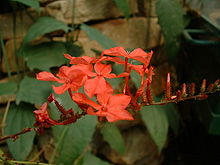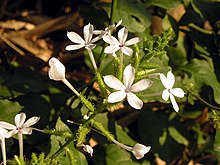Plumbago
| Plumbago | |
|---|---|

| |
| Plumbago auriculata | |
| Scientific classification | |
| Kingdom: | Plantae |
| Clade: | Tracheophytes |
| Clade: | Angiosperms |
| Clade: | Eudicots |
| Order: | Caryophyllales |
| Family: | Plumbaginaceae |
| Genus: | Plumbago Tourn. ex L. (1753) |
| Type species | |
| Plumbago europaea L.
| |
| Species[1] | |
|
23; see text | |
| Synonyms[1] | |
| |
Plumbago is a genus of 23 species of flowering plants in the family Plumbaginaceae, native to warm temperate to tropical regions of the world. Common names include plumbago and leadwort (names which are also shared by the genus Ceratostigma).
Description
[edit]

The species include herbaceous plants and shrubs growing to 0.5–2 m (1.6–6.6 ft) tall. The leaves are spirally arranged, simple, entire, 0.5–12 cm (0.20–4.72 in) long, with a tapered base and often with a hairy margin. The flowers are white, blue, purple, red, or pink, with a tubular corolla with five petal-like lobes; they are produced in racemes.
The flower calyx has glandular trichomes (hairs), which secrete a sticky mucilage that is capable of trapping and killing insects; it is unclear what the purpose of these trichomes is; protection from pollination by way of "crawlers" (ants and other insects that typically do not transfer pollen between individual plants), or possible protocarnivory.[2]
Mature plumbago leaves often have a whitish residue on their undersides, a feature that can confuse gardeners. While this white material resembles a powdery mildew disease or a chemical spray deposit, it is actually a natural exudate from "chalk" glands that are found on the Plumbago species.[3]
Taxonomy
[edit]The generic name, derived from the Latin words plumbum ("lead") and agere ("to resemble"), was first used by Pliny the Elder (23-79) for a plant known as μολύβδαινα (molybdaina) to Pedanius Dioscorides (ca. 40-90).[4][5][6] This may have referred to its lead-blue flower colour[citation needed], the ability of the sap to create lead-colored stains on skin,[7] or Pliny's belief that the plant was a cure for lead poisoning.[8]
Species
[edit]Plants of the World Online accepts 23 species.[1]
- Plumbago africana (Lam.) Christenh. & Byng – southwestern Angola, Namibia, and Cape Provinces of South Africa
- Plumbago amplexicaulis Oliv. Democratic Republic of the Congo, Tanzania, Zambia, and Mozambique
- Plumbago aphylla Bojer ex Boiss. – Madagascar, Tanzania (Mbudya Island), Aldabra, Europa Island
- Plumbago arabica (Boiss.) Christenh. & Byng – eastern Arabian Peninsula and western and central India
- Plumbago auriculata Lam. – Mozambique and South Africa
- Plumbago caerulea Kunth – northwestern Venezuela, Colombia, Peru, Bolivia, northern and central Chile, and northern Argentina
- Plumbago ciliata Engl. ex Wilmot-Dear – southern Tanzania
- Plumbago dawei Rolfe southwestern Ethiopia, Kenya, Uganda, Tanzania, and Madagascar
- Plumbago europaea L. – Mediterranean to Iraq, Iran, Caucasus, and Turkmenistan
- Plumbago glandulicaulis Wilmot-Dear – northern Tanzania
- Plumbago hunsbergensis van Jaarsv., Swanepoel & A.E.van Wyk – Namibia
- Plumbago indica L. – Indian subcontinent, Indochina, south-central China, Hainan, Philippines, Sumatra, Java, and Sulawesi
- Plumbago ituriensis Ntore – Democratic Republic of the Congo
- Plumbago madagascariensis M. Peltier – Madagascar
- Plumbago montis-elgonis Bullock – southwestern Ethiopia, Kenya, and northwestern Tanzania
- Plumbago pearsonii L. Bolus – Namibia (Naukluft Mountains)
- Plumbago pendula (Balf.f.) Christenh. & Byng – north-central Socotra
- Plumbago pulchella Boiss. – Mexico
- Plumbago socotrana (Balf.f.) ined. – Socotra
- Plumbago stenophylla Wilmot-Dear – southeastern Kenya
- Plumbago tristis Aiton – southwestern Cape Provinces
- Plumbago wissii Friedr. – Namibia (Brandberg)
- Plumbago zeylanica L. – tropical and subtropical Americas, sub-Saharan Africa, Madagascar, Indian subcontinent, Indochina, southern China, Malesia, New Guinea, and northern and eastern Australia
See also
[edit]References
[edit]- ^ a b c "Plumbago Tourn. ex L." Plants of the World Online. Retrieved 1 April 2024.
- ^ Schlauer, Jan (1997). ""New" data relating to the evolution and phylogeny of some carnivorous plant families". Carnivorous Plant Newsletter. 26 (2). International Carnivorous Plant Society: 34–38. doi:10.55360/cpn262.js506. S2CID 254773038.
- ^ Doug Caldwell. New thrips found on Plumbago (PDF). Collier County Extension, University of Florida & Institute of Food and Agricultural Sciences.
- ^ Quattrocchi, Umberto (2000). CRC World Dictionary of Plant Names. Vol. 3 M-Q. CRC Press. p. 2117. ISBN 978-0-8493-2677-6.
- ^ Austin, Daniel F. (2004). Florida Ethnobotany. CRC Press. pp. 527–528. ISBN 978-0-8493-2332-4.
- ^ μολύβδαινα. Liddell, Henry George; Scott, Robert; A Greek–English Lexicon at the Perseus Project.
- ^ Schmelzer, G.H.; A. Gurib-Fakim (2008). Medicinal Plants. Plant Resources of Tropical Africa. p. 427. ISBN 978-90-5782-204-9.
- ^ Burke, Don (2005). The Complete Burke's Backyard: the Ultimate Book of Fact Sheets. Murdoch Books. p. 268. ISBN 978-1-74045-739-2.
